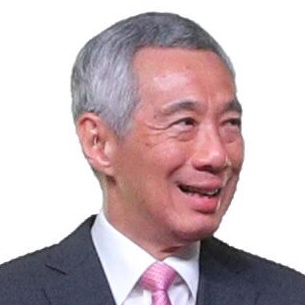People’s Daily Interview with PM Lee Hsien Loong
PM Lee Hsien Loong's written interview with the People's Daily newspaper from China.
* * * * *
Question 1: Singapore-China relations

People's Daily: Singapore-China relationship can be considered to have advanced with times in 2017, achieving positive progress in various areas of cooperation. You have made an official visit to China in September last year, reaching consensus with President Xi Jinping on the development of bilateral relationship between China and Singapore. What is your outlook for Singapore-China relationship in 2018?

PM Lee Hsien Loong: Singapore-China relations are strong. The foundations were laid down by our leaders long before we established formal diplomatic relations in 1990. This year marks the 40th anniversary of Mr Deng Xiaoping’s visit to Singapore. That visit took place two years after Mr Lee Kuan Yew visited China in 1976. Our bilateral relations have since flourished with regular exchanges of visits, including the visit by President Xi Jinping in 2015 marking the 25th Anniversary of the establishment of diplomatic ties between Singapore and China.
President Xi Jinping said that Singapore and China share common interests in many areas. I agree. We are two very different countries, in terms of population, demographic composition, economic size, and geography. But we have managed to work together to pursue win-win cooperation over a wide range of issues, from trade and investment to social governance, human resource development, financial services, legal and judicial matters.
Since my meeting with President Xi last September, China has held the 19th Party Congress and Lianghui. These meetings set strategic directions for China’s development and foreign policy in a new era. China will play a growing role in regional and global issues. Singapore will continue to support China’s constructive participation in the regional architecture as well as the international system.
Our developing partnership is reflected in our three Government-to-Government projects. The Suzhou Industrial Park facilitated China’s early industrialisation efforts and has been replicated in other Chinese cities. We then embarked on the Tianjin Eco-City to support China’s sustainable and green develop-ment. The third Government-to-Government project, the Chongqing Connectivity Initiative, is a priority demonstration project under China’s Belt and Road (B&R) Initiative, Western Region Development and Yangtze River Economic Belt strategies.
For this year, we have a full bilateral calendar. We are working to complete the upgrading of the China-Singapore Free Trade Agreement. Singapore will host the annual Joint Council for Bilateral Cooperation (co-chaired at the DPM level) and the Second Legal and Judicial Roundtable, while China will host the Social Governance Forum and Forum on Leadership. Through these high-level platforms and many other exchanges, we hope to take our partnership forward.
Question 2: ASEAN—China Relations

People's Daily: ASEAN is a priority for China’s diplomacy with its neighbouring regions. Singapore takes on the role of ASEAN Chairmanship this year, and continues to undertake the role of country coordinator for ASEAN-China relations for the first half of the year. How does Singapore plan to promote the further development of the ASEAN-China relationship?

PM Lee: China is one of ASEAN’s most important and substantive dialogue partners. China is the top trading partner for most ASEAN Member States. ASEAN is a significant grouping whose cohesion and effectiveness fosters a conducive regional environment for China. The ASEAN-China FTA is one of the world’s largest free trade areas. It is therefore in the interest of both sides that relations remain strong, stable and mutually beneficial.
As ASEAN Chair as well as Country Coordinator for ASEAN-China Dialogue Relations, Singapore will continue to expand and deepen cooperation between the two sides. We upgraded the ACFTA in 2015, and are now working towards the full implementation of the upgrade Protocol. Deepening economic links and improving connectivity will help us to reach the target of US$1 trillion in ASEAN-China trade by 2020.
This year ASEAN and China mark the 15th Anniversary of our Strategic Partnership. Singapore is working with fellow ASEAN Member States and China to chart the future direction of the ASEAN-China relationship through the ASEAN-China Strategic Partnership Vision 2030 statement, which we hope to issue in November 2018.
We have also designated 2018 as the ASEAN-China Year of Innovation. This fits in with Singapore’s ASEAN Chairmanship theme of “Resilience and Innovation”. One of our Chairmanship deliverables is to establish an ASEAN Smart Cities Network. China has the largest number of smart cities in the world, with more than 500 smart city projects underway. We can learn much from China’s experience. We look forward to partnering China in this area to create tangible benefits for our peoples and businesses.
Question 3: Belt & Road Initiative

People's Daily: One of the themes for the “Boao Forum for Asia 2018” is “Globalisation and the Belt & Road”; the establishment of Belt and Road is currently also an important component of Singapore-China cooperation. What do you think are the priorities areas where Singapore’s development strategy and the “Belt and Road” initiative align?

PM Lee: Singapore is an early and strong supporter of China’s Belt and Road (B&R) Initiative. The Initiative will benefit many countries that need more and better infrastructure. It is also compatible with keeping the regional architecture and international system open and inclusive. Thus Singapore and China have agreed to make the B&R Initiative a focal point in our bilateral relations.
We have identified several areas for cooperation under the B&R Initiative. The first is infrastructure connectivity. We have developed the CCI- Southern Transport Corridor (CCI-STC), which will link Chongqing to Qinzhou port (Beibu Gulf, Guangxi) in the south by rail, and from Qinzhou to Singapore and beyond by sea. The CCI-STC will create a direct connection between the overland New Silk Road Economic Belt and the 21st Century Maritime Silk Road, enhancing multi-modal connectivity from Western China to Southeast Asia and the rest of the world. We are also exploring linking up our Single Electronic Windows to support the trade flows along the CCI-STC.
The second area is financial connectivity. Singapore is an international financial centre, one of the largest offshore RMB centres in the world. Singapore banks are actively helping Chinese companies tap the B&R Initiative and expand into Southeast Asia. Chinese banks in Singapore have committed S$100 billion to finance Singaporean and Chinese companies involved in B&R projects, including issuing project bonds to support B&R financing needs. Singapore’s financial centre can also play a useful role in structuring and providing specialised insurance coverage for B&R infrastructure projects. Today, two-thirds of Southeast Asia infra¬structure projects are arranged by Singapore-based project finance teams.
The third priority area is third country collaboration. Many Chinese companies use Singapore as a base for their operations in the region. We can draw on each other’s strengths to jointly develop commercially feasible projects in third countries along the Belt and Road and provide training to officials from B&R participating countries.
Finally, we can work together to offer legal and dispute resolution services to resolve cross border commercial disputes. The strong record of project financing in Singapore is supported by our reputable and credible legal system which has a full suite of mediation, arbitration and litigation services for commercial disputes. By providing investors more options, we will also give them more confidence to pursue cross-border projects.
Question 4: Regional Trade Arrangements

People's Daily: Singapore is currently advancing the Comprehensive Progressive Trans-Pacific Partnership (CPTPP) with ten other countries, and is also negotiating the Regional Comprehensive Economic Partnership (RCEP) with 15 other countries including China. What are your views on the relationship between these different regional trade arrangements in the Asia-Pacific region?

PM Lee: Globalisation and international trade have underpinned the growth and prosperity of many countries, including Singapore and China. But in some countries, the political mood is shifting against them. The US has been a longstanding advocate of free trade and economic multilateralism. However, it has recently taken a radically different approach towards trade, and has taken specific steps to protect domestic industries and reduce its large bilateral trade deficits. These measures have inevitably put pressure on the US’ relations with China and other countries.
As a small nation with an open economy, Singapore is heavily dependent on international trade. If unilateral and tit-for-tat actions escalate into trade wars, the multilateral trading system that has brought countries prosperity for decades will be severely undermined. There will be no winners in a trade war.
China decision to join the WTO in 2001 was a bold one. Since then, China has committed to abide by multilateral rules, including submitting to WTO dispute settlement mechanism. China has benefited from doing this, as have other countries.
Since 2001 China’s economy has developed greatly. China’s share of global GDP and trade volume have also increased dramatically. It is therefore natural that other countries expect China to take on more commitments and contribute more to the global system, by further opening market access for trade in goods and services, and liberalising rules for foreign investments into China. These steps would better match China’s present stage of development. China can do so on a multilateral basis, or through FTAs with regional partners.
The Comprehensive and Progressive Agreement for Trans-Pacific Partnership (CPTPP) and the Regional Comprehensive Economic Partnership (RCEP) are complementary building blocks towards an eventual Free Trade Area of the Asia-Pacific. These two agreements will boost economic growth in the Asia-Pacific and promote a seamless flow of goods, services and business that will benefit all countries. The CPTPP, which was recently signed, is an open and inclusive agreement. We welcome China, and others, to join the CPTPP when they are ready.
We also hope that the RCEP can be concluded soon. The RCEP will create an even larger market comprising nearly half the world’s population and a third of its GDP, and bring significant economic and strategic benefits to its members and the broader Asia Pacific region. If we can sign the RCEP this year, it will, together with the CPTPP, send a clear signal to the world about our commitment to multilateral trade, and our resolve to keep the regional architecture open and inclusive.
Question 5: Cultural Ties

People's Daily: According to Singapore Lianhe Zaobao’s report, China has overtaken Indonesia to become the source country for the largest number of tourists entering Singapore. What are your comments regarding this? Chinese make up the majority of Singapore’s population, hence a lot of PRC Chinese have a natural affinity towards Singapore. You have also received a Chinese education before. What are your views on the historical and cultural linkages between Singapore and China?

PM Lee: China has a population of almost 1,400 million people. The middle class has grown rapidly. Millions of Chinese are travelling overseas for business or leisure. They can be seen everywhere in the world.
Cultural and language similarities make Singapore a popular destination for Chinese tourists. We welcome them. Frequent exchanges between our peoples keep our ties strong and enable us to do more together.
At the same time, Chinese tourists visit Singapore precisely because we are not another Chinese city. They find Singapore a fascinating multiracial and multi-religious country with different cultures and ways of life. Different ethnic groups and religious faiths co-exist side by side, harmoniously. We hope that when Chinese tourists visit us, they can see and appreciate how Singapore is unique, and how our multi-racial national identity influences our place in the world and relations with other countries.
* * * * *
(一)

人民日报: 2017年中新关系可以说与时俱进,各领域的合作都取得积极进展,您于去年9月对中国进行了正式访问,与习近平主席就两国关系发展达成了一系列重要共识。您对2018年中新关系有何展望?

李显龙总理: 2新中关系的牢固基础,是两国领导人早在两国1990年正式建交之前就奠下的。李光耀先生于1976年访华,邓小平先生两年后回访新加坡,今年适逢邓小平先生访问新加坡40周年。之后,新中关系随着两国领导人的频密互访而稳健发展,中国国家主席习近平也于2015年到新加坡进行国事访问,庆祝两国建交25周年。
习主席说过,新中两国在许多领域享有共同利益,我非常同意。新中两国虽然在人口规模和结构、经济规模以及地理环境等方面都大不相同,但还是在许多领域进行双赢的合作,例如贸易投资、社会治理、人力资源培育、金融服务,和法律司法事务等等。
从我去年九月访问中国与习主席会晤至今,中国已召开了十九大和两会,为中国在新时代的发展和外交政策定下了战略方向。中国在区域和国际课题上将扮演日益重要的角色,新加坡将一如既往地支持中国积极参与区域架构和国际体系。
两国日益深化的合作关系体现于三个政府间合作项目。首先是苏州工业园区,它促进了中国早期的工业化过程,也在中国其他城市被复制。之后,我们携手打造天津生态城,支持中国实践可持续发展和绿色发展理念。第三个合作项目是重庆战略性互联互通示范项目,这是中国一带一路、西部大开发、长江经济带等策略下的重点示范项目。
今年,新中两国将举行一系列双边活动。首先,我们正在争取完成中新自由贸易协定升级版的协商工作。另外,一年一度的新中双边合作联合委员会会议(由两国副总理主持)以及第二届法律和司法圆桌会议将在新加坡举行,而新中社会治理高层论坛和新中领导力论坛则会在中国举行。我们希望通过这些高层次平台和其他交流管道,让两国的合作关系更上一层楼。
(二)

人民日报: 东盟是中国周边外交的优先方向,今年新加坡担任东盟轮值主席国,上半年还将继续担任中国—东盟关系协调国,新加坡将如何推动中国—东盟关系进一步深入发展?

李总理: 中国是东盟最重要的对话伙伴和实质合作伙伴之一,也是多数东盟成员国的最大的贸易伙伴。东盟是个具有一定影响力的区域组织,团结、高效,为中国创造有利的区域环境。中国—东盟自由贸易区(ACFTA)是全球最大的自由贸易区之一。因此,维持密切、稳定和互利共赢的关系,对中国和东盟来说都是有利的。
作为东盟轮值主席国以及中国—东盟关系协调国,新加坡将继续致力于扩展和深化双方的合作关系。双方于2015年签署中国—东盟自贸区升级议定书之后,现在正推动自贸协定升级工作的全面落实。随着双方经济联系的深化和互联互通的推进,我们有望在2020年前实现中国—东盟双边贸易额达一万亿美元的目标。
今年是东盟—中国建立战略伙伴关系15周年。新加坡和其他东盟成员国正与中国一起就“中国—东盟战略伙伴关系2030年愿景”进行规划,为东盟 – 中国关系未来发展指明方向。我们希望能于2018年11月公布这份愿景。
2018年也是东盟—中国创新年,这和新加坡东盟主席任期“坚韧团结、创新求变”的主题相符。作为东盟轮值主席国,我们其中一项重点工作是打造一个东盟智慧城市网络。中国目前已经在500个城市开展智慧城市试点工作,是全球智慧城市为数最多的国家。新加坡我们可以向中国学习并借鉴经验。我们也期待在这个领域与中国合作,为我们的人民和企业创造实质利益。
(三)

人民日报: 博鳌亚洲论坛2018年年会的主题之一是“全球化与一带一路”,“一带一路”建设也是当前中新合作的重要内容。在新加坡发展战略与“一带一路”倡议相对接方面,您认为哪些是优先方向?

李总理: 新加坡是最早支持中国“一带一路”倡议的国家之一,也是这项倡议的坚定支持者。许多国家需要更大量、更优质的基础设施, “一带一路”不仅能让它们受益,也与维持开放和包容的区域和目标体系相符。因此,新中两国决定把“一带一路”倡议定为双边合作的重点领域。
两国领导人同意在“一带一路”倡议的几个领域里展开合作。两国联手启动了中新(重庆)互联互通项目的南向通道,以此开辟了连接重庆到和广西北部湾钦州口岸的铁路通道,以及从钦州延续通往新加坡和其他国家的海上通道。新中南向通道将新丝绸之路经济带和21世纪海上丝绸之路直接连接起来,加强了中国西部和东南亚以及世界各地多式联运的互联互通。此外,我们也正在与中方研究如何沿着南向通道推进两国各别的贸易单一窗口对接,进一步优化货物的通关流程。
新中两国另外一个合作领域是金融服务的互联互通。新加坡是个国际金融中心,也是全球最大的离岸人民币清算中心之一。新加坡的银行正积极地协助中国企业通过“一带一路”倡议,进军东南亚市场。在新加坡设立分行的中资银行已承诺为参与“一带一路”项目的新中企业提供1000亿新元的融资支持,包括发行债券来募集“一带一路”建设项目所需的资金。新加坡的金融中心同时也可以为“一带一路”基建项目专门设计和提供保险服务。至今为止,三分之二的东南亚基建项目已由设在新加坡的融资团队所规划。
第三个领域是与第三方国家合作。许多中国企业已利用新加坡作为区域平台。我们可以借助彼此的优势,共同为“一带一路”沿线的第三方国家发展可行的商业项目,并联合为他们的官员提供培训。
最后,新中两国可以在调解及解决跨境商业纠纷方面进行合作,为纠纷各方提供法律咨询和调解服务。新加坡能够在项目融资方面享有良好的纪录,主要是因为我们拥有可靠和具有信誉的司法制度;包括解决商业纠纷的调解、仲裁和诉讼机制。有了更多元化的纠纷解决机制,投资者也将更有信心展开跨境项目。
(四)

人民日报: 当前新加坡正在同其他十国继续推进CPTPP(全面进展的跨太平洋伙伴关系协定),也在同包括中国在内的其他15国谈判RCEP(区域全面经济伙伴关系协定),请问您如何看待亚太地区这些不同的区域贸易安排之间的关系?

李总理: 全球化和国际贸易协助许多国家取得经济增长和繁荣,新加坡和中国也不例外。不过,一些国家的政治氛围正转向排斥全球化和国际贸易。美国向来提倡自由贸易并支持多边经济体系,但最近美国对自由贸易的态度却大幅度转向,采取了保护国内产业的措施,以缩小庞大的双边贸易赤字。这些措施无可避免地将影响美国和中国以及其他国家之间的关系。
作为一个开放型的小规模经济体,新加坡非常依赖国际贸易。如果一些国家单边采取贸易保护主义措施,结果引起相关的反制行动并升级为贸易战,这将严重破坏国际多边贸易体系,而这个体系在过去几十年里是全球许多国家经济繁荣发展的关键。展开贸易战对任何国家来说,都没有好处。
中国在2001年加入世界贸易组织是个大胆的决定。入世后,中国承诺遵守多边贸易体系的规则,包括遵循世贸组织的争端解决机制。这让中国获益,其他国家亦然。
自2001年起,中国的经济迅速起飞,在全球GDP的占比和贸易总额也大幅度增加。在这样的背景下,其他国家自然希望中国能承担更多的责任,为全球体系做出更大的贡献,例如进一步开放商品和服务市场及放宽入华外资条例等。这些举措将更切合中国目前的发展阶段。中国可以通过多边模式或和区域伙伴签署自由贸易协定来推进这方面的工作。
另一方面,跨太平洋伙伴全面进展关系协定(CPTPP)和区域全面经济伙伴关系协定(RCEP)具有一定的互补性,能够协助落实亚太自由贸易区的愿景。这两份协定将推动亚太地区的经济增长,并促进商品、服务和商务的无缝衔接,让所有成员国获益。最近签署的CPTPP是一份开放和具包容性的协定。我们欢迎中国和其他国家在未来加入 CPTPP。
与此同时,我们也希望RCEP的谈判工作能够尽早完成。RCEP将创造更大的市场,涵盖全球近一半人口,并占全球GDP的三分之一,可为成员国和更广大的亚太区域带来显著的经济和战略效益。如果我们能在今年签署RCEP,这份协定加上CPTPP,将传达明确的信息, 那就是:我们致力推动全球多边贸易,并决心确保本区域合作架构的开放性和包容性。
(五)

人民日报: 根据新加坡《联合早报》的最新报道,中国首次超越印度尼西亚,成为新加坡的最大旅客来源国,您对此有何评论?新加坡人口中大多数是华人,因此很多中国人对新加坡有着天然的亲近感,您本人也接受过华文教育,请问您如何看待中新两国之间的这种历史文化联系?

李总理: 中国有近14亿人口,中产阶级的人数也正迅速增长。每年,数以百万计的中国人到国外经商或旅游,足迹遍布世界各地。
新中两国在语言和文化上的共同之处,让新加坡成为中国游客喜爱的旅游地点。我们欢迎中国游客。两国人民的频密交流,能保持双方密切的关系,并为我们创造更大的合作空间。
然而,中国游客选择到新加坡旅游,也正因为新加坡不是中国的另一座城市。他们感受到新加坡独特的风土民情和多元文化色彩。不同种族、宗教信仰的新加坡人,都能在这里和睦共处。我们希望中国游客到访新加坡时,能感受到新加坡这个小岛国的独特之处,也了解我们多元种族的身份认同不仅是生活写照,也影响新加坡在国际社会上的定位及我们同其他国家的关系。
Explore recent content
Explore related topics
